 Backend Development
Backend Development
 Python Tutorial
Python Tutorial
 Three methods to use For loop to traverse Python dictionary (detailed examples)
Three methods to use For loop to traverse Python dictionary (detailed examples)
Three methods to use For loop to traverse Python dictionary (detailed examples)
This article brings you relevant knowledge about python. It mainly introduces three methods on how to use for loop to traverse Python dictionary. Let’s take a look at it together. I hope it will be helpful to everyone. help.
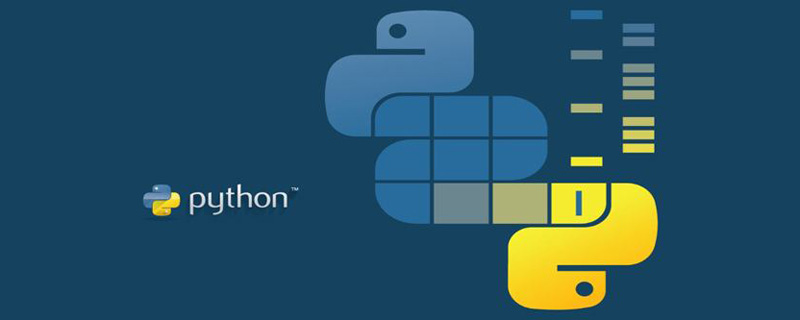
Recommended learning: python video tutorial
In Python, how to use "for" loop to traverse a dictionary?
Today we will demonstrate three methods and learn to traverse nested dictionaries.
Before actual combat, we need to create a dictionary of simulated data.
dict_1 = {'Name': 'Zara', 'Age': 7, 'Class': 'First','Address':'Beijing'}
Method 1: Iterate using For loop index
The easiest way to iterate over a dictionary in Python is to Put directly into the for loop.
Python will automatically treat dict_1 as a dictionary and allow you to iterate over its keys. Then, we can use the index operator to obtain each value.
for key in dict_1: print(key, ":", dict_1[key])
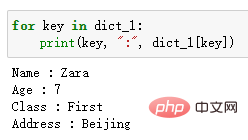
If you want to arrange the keys in alphabetical order, you can use the sorted() method. The specific usage is as follows.
for key in sorted(dict_1): print(key, ":", dict_1[key])
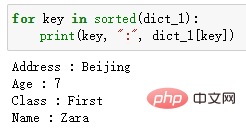
Method 2: Use .keys() index to iterate
Use .keys() to return a Python object containing dictionary keys, you can get Same result as method 1. Likewise, it also needs to be used in conjunction with indexing operators.
for key in dict_1.keys(): print(key, '-->', dict_1[key])
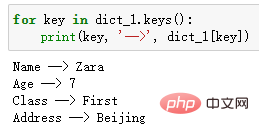
Method 3: Iterate using .items()
In fact, the most "pythonic" and elegant way to traverse a dictionary is The method is to use the .items() method.
print(dict_1.items())

In order to iterate over the keys and values of the transaction_data dictionary, you only need to "unpack" the two items embedded in the tuple, like this:
for k,v in dict_1.items(): print(k,">>",v)
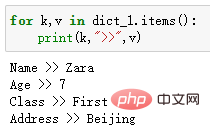
Note that k and v are just standard aliases for "key" and "value", but you can also choose other naming conventions .
For example, we can replace it with a and b, and we will have the same output.
for a,b in dict_1.items(): print(a,"-",b)
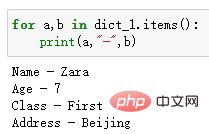
Advanced: Traversing nested dictionaries
Sometimes, we will encounter more complex dictionaries-nested dictionary.
So what should we do in this situation?
dict_2 = {"num_1":{'Name': 'Zara', 'Age': 7, 'Class': 'First','Address':'Beijing'},
"num_2":{'Name': 'BOb', 'Age': 32, 'Class': 'Six','Address':'Shanghai'},
"num_3":{'Name': 'Tom', 'Age': 25, 'Class': 'Second','Address':'Wuhan'}}dict_2
In order to unravel the key-value pairs belonging to each nested dictionary, we can do this:
for k, v in dict_2.items(): if type(v) is dict: for nk, nv in v.items(): print(nk, "→", nv)
Determine whether the value is through the if statement Dictionary, if so, use method 3 mentioned earlier, using .items() for iterative output.
The running results are as follows.

If you only want to decompress part of the dictionary, you can add conditions to the if statement.
for k, v in dict_2.items(): if type(v) is dict and k == 'num_2': for sk, sv in v.items(): print(sk, "-->", sv)
Only outputs the dictionary of num_2. The running results are as follows.
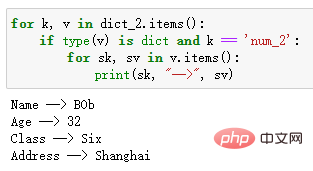
#The above are the tips for using “for” loop to traverse the dictionary in Python.
Recommended learning: python video tutorial
The above is the detailed content of Three methods to use For loop to traverse Python dictionary (detailed examples). For more information, please follow other related articles on the PHP Chinese website!

Hot AI Tools

Undresser.AI Undress
AI-powered app for creating realistic nude photos

AI Clothes Remover
Online AI tool for removing clothes from photos.

Undress AI Tool
Undress images for free

Clothoff.io
AI clothes remover

Video Face Swap
Swap faces in any video effortlessly with our completely free AI face swap tool!

Hot Article

Hot Tools

Notepad++7.3.1
Easy-to-use and free code editor

SublimeText3 Chinese version
Chinese version, very easy to use

Zend Studio 13.0.1
Powerful PHP integrated development environment

Dreamweaver CS6
Visual web development tools

SublimeText3 Mac version
God-level code editing software (SublimeText3)

Hot Topics
 1386
1386
 52
52
 How to run programs in terminal vscode
Apr 15, 2025 pm 06:42 PM
How to run programs in terminal vscode
Apr 15, 2025 pm 06:42 PM
In VS Code, you can run the program in the terminal through the following steps: Prepare the code and open the integrated terminal to ensure that the code directory is consistent with the terminal working directory. Select the run command according to the programming language (such as Python's python your_file_name.py) to check whether it runs successfully and resolve errors. Use the debugger to improve debugging efficiency.
 Can visual studio code be used in python
Apr 15, 2025 pm 08:18 PM
Can visual studio code be used in python
Apr 15, 2025 pm 08:18 PM
VS Code can be used to write Python and provides many features that make it an ideal tool for developing Python applications. It allows users to: install Python extensions to get functions such as code completion, syntax highlighting, and debugging. Use the debugger to track code step by step, find and fix errors. Integrate Git for version control. Use code formatting tools to maintain code consistency. Use the Linting tool to spot potential problems ahead of time.
 Is the vscode extension malicious?
Apr 15, 2025 pm 07:57 PM
Is the vscode extension malicious?
Apr 15, 2025 pm 07:57 PM
VS Code extensions pose malicious risks, such as hiding malicious code, exploiting vulnerabilities, and masturbating as legitimate extensions. Methods to identify malicious extensions include: checking publishers, reading comments, checking code, and installing with caution. Security measures also include: security awareness, good habits, regular updates and antivirus software.
 Can vs code run in Windows 8
Apr 15, 2025 pm 07:24 PM
Can vs code run in Windows 8
Apr 15, 2025 pm 07:24 PM
VS Code can run on Windows 8, but the experience may not be great. First make sure the system has been updated to the latest patch, then download the VS Code installation package that matches the system architecture and install it as prompted. After installation, be aware that some extensions may be incompatible with Windows 8 and need to look for alternative extensions or use newer Windows systems in a virtual machine. Install the necessary extensions to check whether they work properly. Although VS Code is feasible on Windows 8, it is recommended to upgrade to a newer Windows system for a better development experience and security.
 Python: Automation, Scripting, and Task Management
Apr 16, 2025 am 12:14 AM
Python: Automation, Scripting, and Task Management
Apr 16, 2025 am 12:14 AM
Python excels in automation, scripting, and task management. 1) Automation: File backup is realized through standard libraries such as os and shutil. 2) Script writing: Use the psutil library to monitor system resources. 3) Task management: Use the schedule library to schedule tasks. Python's ease of use and rich library support makes it the preferred tool in these areas.
 What is vscode What is vscode for?
Apr 15, 2025 pm 06:45 PM
What is vscode What is vscode for?
Apr 15, 2025 pm 06:45 PM
VS Code is the full name Visual Studio Code, which is a free and open source cross-platform code editor and development environment developed by Microsoft. It supports a wide range of programming languages and provides syntax highlighting, code automatic completion, code snippets and smart prompts to improve development efficiency. Through a rich extension ecosystem, users can add extensions to specific needs and languages, such as debuggers, code formatting tools, and Git integrations. VS Code also includes an intuitive debugger that helps quickly find and resolve bugs in your code.
 Can visual studio code run python
Apr 15, 2025 pm 08:00 PM
Can visual studio code run python
Apr 15, 2025 pm 08:00 PM
VS Code not only can run Python, but also provides powerful functions, including: automatically identifying Python files after installing Python extensions, providing functions such as code completion, syntax highlighting, and debugging. Relying on the installed Python environment, extensions act as bridge connection editing and Python environment. The debugging functions include setting breakpoints, step-by-step debugging, viewing variable values, and improving debugging efficiency. The integrated terminal supports running complex commands such as unit testing and package management. Supports extended configuration and enhances features such as code formatting, analysis and version control.
 Can vs code run python
Apr 15, 2025 pm 08:21 PM
Can vs code run python
Apr 15, 2025 pm 08:21 PM
Yes, VS Code can run Python code. To run Python efficiently in VS Code, complete the following steps: Install the Python interpreter and configure environment variables. Install the Python extension in VS Code. Run Python code in VS Code's terminal via the command line. Use VS Code's debugging capabilities and code formatting to improve development efficiency. Adopt good programming habits and use performance analysis tools to optimize code performance.



